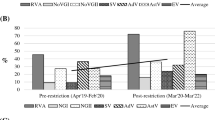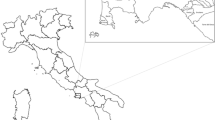Abstract
RT-PCR, nucleotide sequencing, and phylogenetic analysis were performed for genotyping and molecular characterization of noroviruses isolated from Korean groundwater. Among 160 samples collected from 80 sites between 2008 and 2010, 14 samples (8.7 %) from 12 sites were positive for noroviruses (NoVs). The percentages of NoV-positive samples in 2008, 2009, and 2010 were 22.2, 3.2, and 0 %, respectively, representing a yearly decrease. GII-positive samples (n = 9, 5.6 %) outnumbered GI-positive samples (n = 5, 3.1 %). The genotypes of the GI NoVs were GI.2, GI.5, and GI.6, and the genotypes of the GII NoVs were all GII.4. One sample, HM623465, was very similar to CUK-3 and CBNU2 and two GII.4 sequences isolated from the stool of Korean gastroenteritis patients. A BLASTN search revealed several nucleotide sequences highly similar to those of NoVs isolated in this study. The original isolation sources for these similar NoVs were mostly stool (n = 731, 80.0 %) and groundwater (n = 135, 14.8 %), and all the countries from which they were isolated were almost in Asia (96.0 %); specifically, China (n = 192, 21.0 %), Japan (n = 383, 41.9 %), Korea (n = 296, 32.4 %), and other Asian countries (n = 6, 0.7 %). These results suggest that Korean groundwater might be contaminated with NoVs from the stool of infected patients and that these NoVs in turn cause new cases of gastroenteritis through a typical fecal-oral route with region-specific circulation. Therefore, it is important to properly treat sewage, which may include waterborne viruses and manage point sources in groundwater for national health and sanitation. In addition, continuous molecular surveillance remains important for understanding circulating NoVs.

Similar content being viewed by others
References
Blanton, L. H., Adams, S. M., Beard, R. S., Wei, G., Bulens, S. N., Widdowson, M. A., et al. (2006). Molecular and epidemiologic trends of caliciviruses associated with outbreaks of acute gastroenteritis in the United States, 2000–2004. Journal of Infectious Diseases, 193, 413–421.
Bruggink, L., & Marshall, J. (2011). The relationship between health care and nonhealth care norovirus outbreak settings and norovirus genotype in Victoria, Australia, 2002–2005. Journal of Microbiology, Immunology, and Infection, 44, 241–246.
Celico, F., Varcamonti, M., Guida, M., & Naclerio, G. (2004). Influence of precipitation and soil on transport of fecal enterococci in fractured limestone aquifers. Applied Environmental Microbiology, 70, 2843–2847.
Cho, J. C., & Kim, S. J. (2000). Increase in bacterial community diversity in subsurface aquifers receiving livestock wastewater input. Applied Environmental Microbiology, 66, 956–965.
Fong, T. T., Mansfield, L. S., Wilson, D. L., Schwab, D. J., Molloy, S. L., & Rose, J. B. (2007). Massive microbiological groundwater contamination associated with a waterborne outbreak in Lake Erie, South Bass Island, Ohio. Environmental Health Perspectives, 115, 856–864.
Gallay, A., De Valk, H., Cournot, M., Ladeuil, B., Hemery, C., Castor, C., et al. (2006). A large multi-pathogen waterborne community outbreak linked to faecal contamination of a groundwater system, France, 2000. Clinical Microbiology & Infection, 12, 561–570.
Gong, Y. W., Oh, B. Y., Kim, H. Y., Lee, M. Y., Kim, Y. H., Go, J. M., et al. (2008). Molecular epidemiologic investigation of norovirus infections in Incheon city, Korea, from 2005 to 2007. Journal of Bacteriology and Virology, 38, 249–257.
He, Y. Q., Ma, H. W., Yao, X. J., Bu, Q. L., Yang, H., Huang, W., et al. (2010). Norovirus gastroenteritis outbreak is associated with contaminated drinking water in South China. Food and Environmental Virology, 2, 207–210.
Iritani, N., Kaida, A., Kubo, H., Abe, N., Goto, K., Ogura, H., et al. (2010). Molecular epidemiology of noroviruses detected in seasonal outbreaks of acute nonbacterial gastroenteritis in Osaka City, Japan, from 1996–1997 to 2008–2009. Journal of Medical Virology, 82, 2097–2105.
Jiang, S. C., Chu, W., & He, J. W. (2007). Seasonal detection of human viruses and coliphage in Newport Bay, California. Applied and Environmental Microbiology, 73, 6468–6474.
Jones, S., Douarre, P. E., O’Leary, J., Corcoran, D., O’Mahony, J., & Lucey, B. (2011). Validation of a norovirus multiplex real-time RT-PCR assay for the detection of norovirus GI and GII from faeces samples. British Journal of Biomedical Science, 68, 116–119.
Jung, W. Y., Eom, J. H., Kim, B. J., Yun, M. H., Ju, I. S., Kim, C. S., et al. (2010). Investigation of norovirus occurrence and influence of environmental factors in food service institutions of ChungCheong area. Journal of Food Hygiene Safety, 25, 153–161.
KCDC. (2006). Epidemiological investigation report of mass food poisoning in the Metropolitan area, Korea, 2006. In E. I. Do (Ed.), Service (pp. 169–181). Seoul: Korea centers for disease control and prevention.
KFDA. (2012). Norovirus gastroenteritis in 2011. Resource document. Korea Food & Drug Administration. Retrieved on 7 February 2011 from http://www.kfda.go.kr/index.kfda?mid=56&seq=16778&cmd=v.
Kim, S. H., Cheon, D. S., Kim, J. H., Lee, D. H., Jheong, W. H., Heo, Y. J., et al. (2005). Outbreaks of gastroenteritis that occurred during school excursions in Korea were associated with several waterborne strains of norovirus. Journal of Clinical Microbiology, 43, 4836–4839.
Koh, S. J., Cho, H. G., Kim, B. H., & Choi, B. Y. (2011). An outbreak of gastroenteritis caused by norovirus-contaminated groundwater at a waterpark in Korea. Journal of Korean Medical Science, 26, 28–32.
Kvitsand, H. M., & Fiksdal, L. (2010). Waterborne disease in Norway: Emphasizing outbreaks in groundwater systems. Water Science and Technology, 61, 563–571.
Leclerc, H., Edberg, S., Pierzo, V., & Delattre, J. M. (2000). Bacteriophages as indicators of enteric viruses and public health risk in groundwaters. Journal of Applied Microbiology, 88, 5–21.
Lee, S. G., Jheong, W. H., Suh, C. I., Kim, S. H., Lee, J. B., Jeong, Y. S., et al. (2011a). Nationwide groundwater surveillance of noroviruses in South Korea, 2008. Applied Environmental Microbiology, 77, 1466–1474.
Lee, C., & Kim, S. J. (2008). The genetic diversity of human noroviruses detected in river water in Korea. Water Research, 42, 4477–4484.
Lee, H., Kim, M., Lee, J. E., Lim, M., Kim, M., Kim, J. M., et al. (2011b). Investigation of norovirus occurrence in groundwater in metropolitan Seoul, Korea. Science of the Total Environment, 409, 2078–2084.
Lee, G., & Lee, C. (2008). Molecular detection and characterization of human enteroviruses in Korean surface water. Journal of Microbiology, 46, 319–324.
Lee, H. J., Lee, S. W., Bang, J. H., Lim, D. J., En, S. H., Park, M. S., et al. (2003). Norwalk-virus food poisoning epidemiological investigation, Seoul, Korea, 2003. In E. I. Do (Ed.), Service (pp. 103–113). Seoul: Korea Centers for Disease Control and Prevention.
Lee, S. G., Lee, S. H., Park, S. W., Suh, C. I., Jheong, W. H., Oh, S., et al. (2011c). Standardized positive controls for detection of norovirus by reverse transcription PCR. Virology Journal, 8, 260.
Locas, A., Barthe, C., Barbeau, B., Carriere, A., & Payment, P. (2007). Virus occurrence in municipal groundwater sources in Quebec, Canada. Canadian Journal of Microbiology, 53, 688–694.
Macler, B. A., & Merkle, J. C. (2000). Current knowledge on groundwater microbial pathogens and their control. Hydrogeology Journal, 8, 29–40.
Mathijs, E., Denayer, S., Palmeira, L., Botteldoorn, N., Scipioni, A., Vanderplasschen, A., et al. (2011). Novel norovirus recombinants and of GII.4 sub-lineages associated with outbreaks between 2006 and 2010 in Belgium. Virology Journal, 18, 310.
NGWA. (2010). Groundwater use for America. Resource document. National Ground Water Association. Retrieved on 7 February 2011 from www.ngwa.org/Documents/Awareness/usfactsheet.pdf.
Okada, M., Ogawa, T., Kaiho, I., & Shinozaki, K. (2005). Genetic analysis of noroviruses in Chiba Prefecture, Japan, between 1999 and 2004. Journal of Clinical Microbiology, 43, 4391–4401.
Park, Y., Cho, Y. H., & Ko, G. (2011). A duplex real-time RT-PCR assay for the simultaneous genogroup-specific detection of noroviruses in both clinical and environmental specimens. Virus Genes, 43, 192–200.
Park, K. S., Jeong, H. S., Baek, K. A., Lee, C. G., Park, S. M., Park, J. S., et al. (2010). Genetic analysis of norovirus GII.4 variants circulating in Korea in 2008. Archives of Virology, 155, 635–641.
Park, K. S., Yeo, S. G., Jeong, H. S., Baek, K. A., Kim, D. U., Shin, M. H., et al. (2012). Updates on the genetic variants of Norovirus in sporadic gastroenteritis in Chungnam Korea, 2009–2010. Virology Journal, 9, 29.
Puustinen, L., Blazevic, V., Huhti, L., Szakal, E. D., Halkosalo, A., Salminen, M., et al. (2012). Norovirus genotypes in endemic acute gastroenteritis of infants and children in Finland between 1994 and 2007. Epidemiology and Infection, 140, 268–275.
Quanrud, D. M., Carroll, S. M., Gerba, C. P., & Arnold, R. G. (2003). Virus removal during simulated soilaquifer treatment. Water Research, 37, 753–762.
Radin, D., & D’Souza, D. H. (2011). Simple and rapid detection of human norovirus from produce using SYBR green I-based real-time RT-PCR. Food and Environmental Virology, 3, 121–129.
Romani, S., Mohebbi, S. R., Hosseini, S. M., Azimzadeh, P., Vahedi, M., Derakhshan, F., et al. (2012). Prevalence of norovirus infection in children and adults with acute gastroenteritis, Tehran, Iran, 2008–2009. Food and Environmental Virology, 4, 1–5.
Shieh, Y. C., Baric, R. S., Woods, J. W., & Calci, K. R. (2003). Molecular surveillance of enterovirus and norwalk-like virus in oysters relocated to a municipal-sewage-impacted gulf estuary. Applied and Environmental Microbiology, 69, 7130–7136.
UNESCO. (2003). Water for people, water for life. Paris, France: United Nations Educational, Scientific and Cultural Organization.
USEPA. (2000). Improved enumeration methods for the recreational water quality indicators: Enterococci, and Escherichia coli, EPA-821-R-97-004. Washington, DC: Office of Science and Technology, U.S. Environmental Protection Agency.
USEPA. (2001). Chapter 14: USEPA manual of methods for virology, EPA-600-4-84-013 (N14). Washington, DC: Office of Research and Development, U.S. Environmental Protection Agency.
Vega, E., Barclay, L., Gregoricus, N., Williams, K., Lee, D., & Vinjé, J. (2011). Novel surveillance network for norovirus gastroenteritis outbreaks, United States. Emerging Infectious Diseases, 17, 1389–1395.
Yu, J. H., Kim, N. Y., Koh, Y. J., & Lee, H. J. (2010). Epidemiology of foodborne Norovirus outbreak in Incheon, Korea. Journal of Korean Medical Science, 25, 1128–1133.
Zheng, D. P., Ando, T., Fankhauser, R. L., Beard, R. S., Glass, R. I., & Monroe, S. S. (2006). Norovirus classification and proposed strain nomenclature. Virology, 346, 312–323.
Zhou, X., Li, H., Sun, L., Mo, Y., Chen, S., Wu, X., et al. (2012). Epidemiological and molecular analysis of a waterborne outbreak of norovirus GII.4. Epidemiology and Infection, 8, 1–8.
Acknowledgments
This research was supported by a fund from the National Institute of Environmental Research, Republic of Korea.
Author information
Authors and Affiliations
Corresponding author
Additional information
Gyu-Cheol Lee and Weon-Hwa Jheong contributed equally to this work.
Rights and permissions
About this article
Cite this article
Lee, GC., Jheong, WH., Jung, G.S. et al. Detection and Molecular Characterization of Human Noroviruses in Korean Groundwater Between 2008 and 2010. Food Environ Virol 4, 115–123 (2012). https://doi.org/10.1007/s12560-012-9084-y
Received:
Accepted:
Published:
Issue Date:
DOI: https://doi.org/10.1007/s12560-012-9084-y




